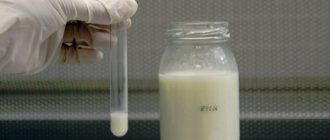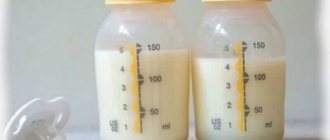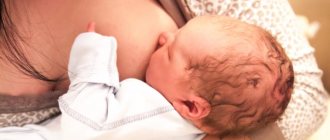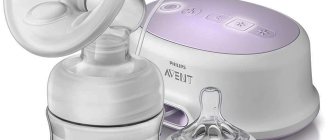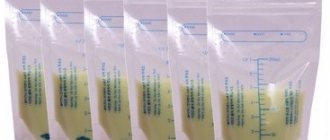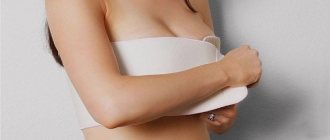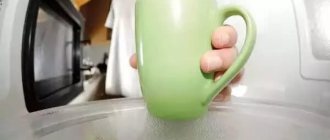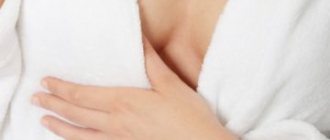A runny nose accompanies many infectious diseases. Adults sometimes do not focus their attention on it, however, for children it can bring serious complications, including sinusitis, otitis media, rhinitis, and bronchitis. Snot clogs the narrow nasal passages, which can cause swelling of the mucous membrane. Having a runny nose is difficult for anyone; children, due to difficulty breathing, begin to experience problems sleeping and eating. It is difficult for them to take a bottle, breast, or even just breathe through their mouth.
Breast milk for a runny nose in infants is the most common advice any grandmother gives to a new mother, but is it really the best medicine or a myth? This recipe is passed down from one generation to the next, as traditional medicine was common in the past. Now many mothers try this method, fearing for the baby’s health; they consider medications harmful, but breast milk is a proven method.
Oils and water solutions for instillation into the nose
treatment of runny nose
- the liquid substance penetrates into all parts of the nasal passage;
- instillation with a pipette allows you to extremely accurately measure the required amount of the medicinal substance;
- Ingredients for making liquid forms are available and varied.
The most common, simple, effective method for a runny nose in a baby is the use of a saline solution, which:
- quickly thins mucus;
- promotes its discharge from the nose;
- cleanses the nasal passages;
- prevents the discharge from drying out and crusts forming.
For preparation, use boiled water at room temperature in the amount of one glass with a quarter teaspoon of table or sea salt diluted in it. Instill 2-3 drops every quarter of an hour.
The same solution is used to delicately rinse the baby’s nasal passages: instill 6-8 drops of the solution, wait a couple of minutes for the mucus to liquefy, then carefully suck out the discharge using a small syringe bulb.
The pear is used only to remove mucus; it should not be used to irrigate the baby’s nasal passages: there is a high probability of damage to the mucous membrane. In addition, the strong pressure of the injected fluid threatens the throwing of mucus into the canal connecting the nasopharynx with the middle ear, and inflammation of the latter.
The mucous membrane of the nasal passages in a child of the first year of life is very delicate and sensitive; folk medicines for its treatment are used in multiple dilutions.
Antimicrobial drops: the onion is grated, the pulp is squeezed through gauze folded in four. The resulting juice is diluted at the rate of one part juice to 20-25 parts boiled water. Inject 2-3 drops into each nasal passage with a pipette 3-4 times a day.
Kalanchoe juice causes itching of the mucous membrane, the child sneezes, due to which the nasal passages are independently and intensively cleared of mucus. The juice is squeezed from the washed leaf of the plant, diluted with water at the rate of one part juice to 10-12 parts boiled water. Inject 2-3 drops into each nostril with a pipette 3-4 times a day.
Oil drops for a baby with a runny nose: take two or three drops of each ingredient, shake thoroughly before use, inject a couple of drops into the nasal passage 4 times a day:
- Luke;
- garlic;
- carrots;
- beets;
- sea buckthorn oils;
- boiled water.
Any vegetable oil can be used for drops: sunflower, olive, etc.
Why is milk used for treatment?
The main purpose of breast milk is to nourish and support the baby’s immune system. Dripping milk into the nose was especially popular for the following reasons:
- effectiveness for physiological runny nose, for example, dry air, irritation of the nasal mucosa, injury;
- strengthening nasal vessels;
- improved breathing and exudate release.
Drinking breast milk is indeed effective, but against the backdrop of the baby’s absolute health. You can also use it as an ambulance to soften crusts before carrying out hygiene procedures. This is where the benefit of milk for a runny nose in newborns and young children ends.
Features of a runny nose in infants
A runny nose in adults is much easier, thanks to the wide clearance of the nasal passages, the ability to fully blow your nose, and a huge range of pharmaceuticals and traditional medicine methods for treating the symptoms of rhinitis. There are 4 main types of runny nose in infants:
- Physiological (not requiring specific treatment). Physiological rhinitis occurs against the background of adaptation of a small organism to the external environment. It usually occurs before 3 months and is not accompanied by additional symptoms. As the mucous membranes of the nasal passages form, which occurs after 10 months of life, the runny nose goes away.
- Infectious or viral rhinitis. An infectious disease occurs due to bacterial or viral damage to the mucous membranes of the newborn’s nose. In addition to a runny nose, other symptoms include: swelling of the nasal passages, difficulty breathing, increased body temperature. Irritation of the skin around the nasolabial triangle often occurs. Children's appetite worsens, the volume of natural ventilation of the lungs decreases, and shortness of breath appears. In some cases, an attack of respiratory failure may occur.
- Allergic rhinitis. A runny nose of an allergic nature occurs against the background of a negative reaction to certain irritants: pollen and household dust, animal hair, cosmetics or perfumes, household chemicals. In some cases, adapted milk formulas can provoke irritation of the mucous membranes of the nasal passages, especially if it was not possible to immediately select the child’s nutrition during artificial feeding. Additional symptoms of allergic rhinitis may include increased watery eyes, sneezing, redness and itching in the eyes.
- Vasomotor rhinitis. A rare but common clinical case, the peculiarity of which is a violation of the vascular functionality of the mucous membranes of the nasal passages for various reasons.
Predisposing factors to the development of a runny nose in infants are traumatic injury to the nose, deviated nasal septum, and anatomical features of the osteochondral tissue of the nose. In practical neonatology and pediatrics, there have been cases of death from a runny nose in newborns due to the inability to compensate for the lack of nasal breathing with the mouth. If the nose is not cleansed sufficiently or there is an excessive accumulation of mucous secretions, suffocation may occur.
Important! A common complication of a runny nose in infants is bronchitis, focal pneumonia, and catarrhal otitis media. If the child feels unwell, if “croaking” and wheezing sounds appear instead of full breathing, if the nasolabial triangle turns blue, or if there is loss of appetite, the child should be shown to a doctor, and if symptoms rapidly increase, an ambulance should be called
Helpful: I can’t smell or taste, what should I do?
Different types of runny nose
Rhinitis is divided into groups depending on the nature of the process occurring in the nasal cavity (for example, catarrhal or purulent) and the cause that provoked the development of the disease.
Infectious runny nose
The symptoms of rhinitis caused by infection depend on the stage of development of the disease. At the initial stage, discomfort appears in the nose and the sense of smell decreases. The baby feels lethargic and weak, and his appetite worsens.
Then the catarrhal phase begins: the child’s nose stops breathing, mucus accumulates in the sinuses and nasopharynx. It has a liquid consistency and light color.
Nasal congestion may be accompanied by a cough and fever.

It is unacceptable to ignore a runny nose in infants
The catarrhal stage of rhinitis development is replaced by a phase of mucopurulent discharge. The mucus in the nose becomes cloudy, acquires a yellowish or greenish tint, and thickens. She gives off an unpleasant odor. Despite this, the baby gradually begins to feel better and recovers.
Allergic runny nose
With an allergic rhinitis, a child experiences itching, sneezing and nasal congestion. When a baby sneezes, a certain amount of mucus is released. Often, with rhinitis of allergic origin, manifestations from some other organs can be observed:
- lacrimation;
- rashes on the skin;
- redness of the sclera of the eyes;
- cough.
Important! The temperature during allergic rhinitis rarely increases.
Most often, to treat allergic rhinitis, it is enough to eliminate the allergen and take an antihistamine recommended for use in infants.
Vasomotor rhinitis
Excessive duration of the disease with adequate treatment may indicate vasomotor rhinitis. The main symptoms of this runny nose are difficulty breathing, swelling and nasal discharge. In most cases, the child has a headache, decreased appetite, and the functioning of taste buds is disrupted.
The basis of the disease is a violation of the vascular tone of the nasal mucosa, and not an inflammatory process. Therefore the temperature does not rise.
Important! Parents should start to worry if a runny nose lasts more than three weeks. In this case, the baby must be shown to a specialist. If rhinitis is not treated promptly, the disease can become chronic.
Breast milk for a runny nose
Baby restlessly eats breast milk
Many parents try to treat their young children for rhinitis using “grandmother’s” methods, one of which involves instilling mother’s milk into the nose.
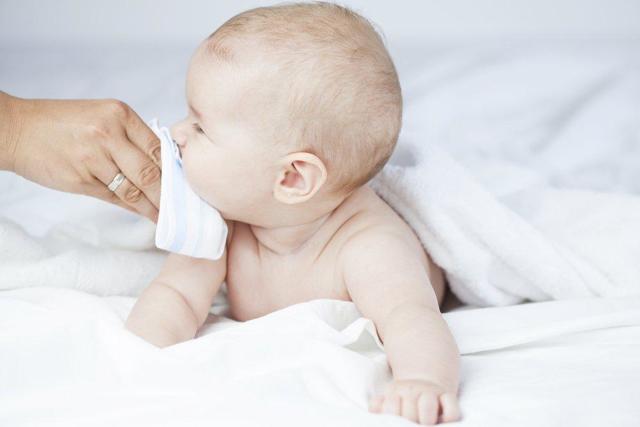
Using breast milk for treatment will cause more harm
Composition of breast milk
Breast milk itself has a very useful composition, allowing the baby to receive all the nutrients necessary for active growth and development:
- biologically active water (78%);
- proteins (1%);
- fats (4%);
- carbohydrates (7%);
- vitamins, hormones, growth factors, etc. (1%).
Why is milk used for treatment?
The idea of putting breast milk in the nose of a newborn with a runny nose did not appear yesterday. She is many centuries old. In the old days, traditional medicine was very poorly developed; many residents of remote villages were deprived of it altogether. Thus was born the idea of using the mother product as a medicine. Many confirm the effectiveness of the method.
Modern medicine answers the question of whether it is possible to try dripping breast milk into a baby’s nose with a sharp negative. There are very specific reasons for this, which should not be ignored.
The dangers of breast milk
Experts consider it unacceptable to use breast milk as medicine. It contains lactic acid. When it enters the nasal cavity, an environment favorable for the proliferation of various pathogenic microbes is formed. As a result, the baby will not only not be freed from a runny nose, but will also develop another, more serious and health-damaging ailment.
Possible complications
When breast milk is used to treat a runny nose, the bacterial infection may spread beyond the sinus lining. This will lead to pharyngitis, otitis, or even laryngitis with the development of false croup.
Doctor Komarovsky's opinion
Is it possible to bathe a child with a runny nose without fever?
The famous doctor Komarovsky believes that the mother’s breast, along with its contents, should under no circumstances perform a healing function.
The specialist is confident that breast milk is not only useless in ridding the baby of rhinitis, but can also cause him some harm.
One drop, of course, will not kill the baby, but if you use the folk remedy regularly, serious problems can arise.
How to cure a runny nose
Is it possible to give manta to a child with a runny nose or cold?
To treat a runny nose, it is recommended to use the methods proposed by traditional medicine: drip vasoconstrictor or antiallergic drops into the nose, use antiviral and antipyretic drugs, rinse the child’s nose, etc.
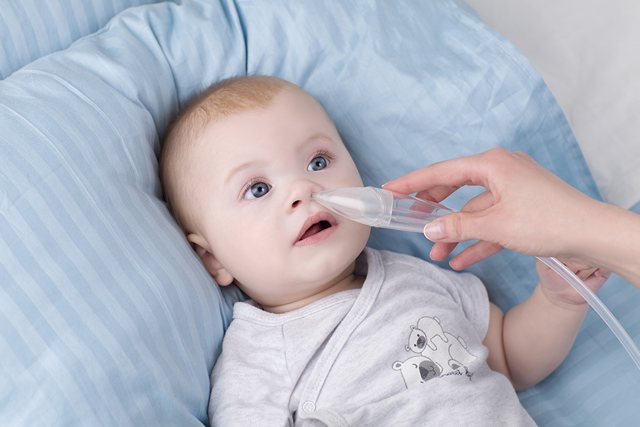
Treatment for rhinitis should be prescribed by a pediatrician
Despite the fact that rhinitis is not considered a serious disease, you should consult your pediatrician for treatment. The doctor knows best how many drops to put into the nose and how many tablets to use in a particular case.
Possible complications after a runny nose
The most common complications after a runny nose include:
- sinusitis;
- tonsillitis;
- pharyngitis;
- tracheitis;
- bronchitis;
- tonsillitis;
- pneumonia;
- inflammation of the skin on the wings of the nose;
- transition of rhinitis to a chronic form, etc.
Prevention
Preventing a runny nose is easier than curing it. Prevention of the disease comes down to following these simple recommendations:
- Regularly carry out wet cleaning in the children's room.
- Limit your baby's potential contact with possible allergens as much as possible.
- Regularly ventilate your child's room.
- Include foods containing vitamins and microelements in sufficient quantities in your baby’s diet.
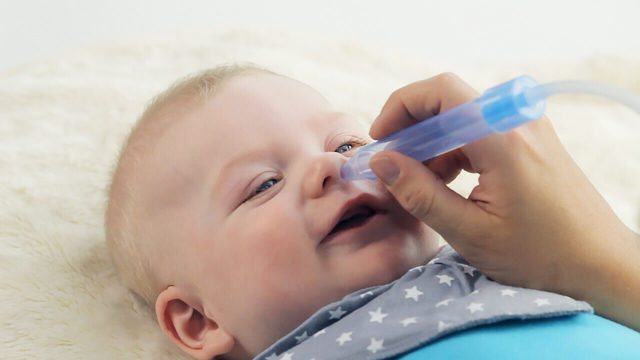
The child's health needs to be monitored regularly
Few parents manage to raise a child and never experience a runny nose. Illness is not a reason to panic, but an incentive to make every effort to cure the baby.
Video
Is it possible to put drops in a child’s nose?
Young mothers often use their own milk to combat children's runny nose. It is assumed that immunoglobulins, together with protective cells, will quickly cope with the infection without harm to the child’s body. New parents refuse to use classical medicines, trying to protect the baby.
Despite the benefits of mother's milk, it is not so harmless when introduced into the nasal passages of a baby. The only positive aspect of this treatment is hydration. The biological fluid softens the crusts and in the first minutes after instillation will make the baby's breathing easier.
The harm of treating a runny nose with this method has long had a solid evidence base.
- Milk is a nutrient medium, including for pathogenic microorganisms. When administered into the nose, favorable conditions are created for the growth of bacterial colonies.
- After a while, the curdled milk will begin to cause discomfort to the baby, disrupting his breathing.
- Liquid flowing into the nose under high pressure can enter the auditory tube. The anatomical structure of the ENT organs in children creates favorable conditions for this. This process leads to the development of an inflammatory process in the middle ear - acute otitis media.
Dangerous aspects of such a remedy
The main harm that treatment of a runny nose with breast milk can cause is the strengthening of the infectious form. The lactose contained in the product becomes a beneficial environment for pathogens that provoke pathogenic rhinitis - the appearance of purulent discharge in the snot and constant congestion.
When milk gets into the nasal passages, the infection begins to spread further throughout the body - through the throat and paranasal sinuses. Complications of a very serious nature may begin, such as pharyngitis, otitis media, sinusitis. All these diseases are very dangerous and often end in the child’s hospitalization.
Before instilling breast milk into the nose, it is recommended to consult a doctor and follow his recommendations, using medications that are not harmful to the child’s body.
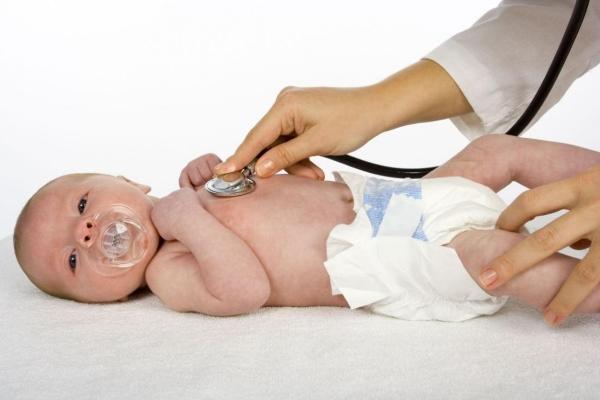
How to quickly cure rhinitis?

If you do not start treating an infectious viral or allergic runny nose in time, it can take a chronic form. In this case, unpleasant symptoms will bother the person throughout his life.
There are medicinal and traditional methods for treating a runny nose in infants.
It is important to pre-examine the child. To successfully and quickly get rid of rhinitis, you need to determine its type
The treatment regimen should be selected by a pediatrician.
Treatment with medications
Pharmacies sell many different medications for the common cold. Please note that not all of them are suitable for children. Medicines for children must be hypoallergenic, safe, and non-addictive. It is advisable to choose products made on a natural basis.
For rhinitis caused by infections and viruses, antiviral, antibacterial, immunomodulatory and antiseptic drugs are used.
Children's medications for rhinitis include:

- Anaferon;
- Isofra;
- Polydex;
- Arbidol;
- Kagocel;
- Derinat;
- Viferon;
- Albucid;
- Protargol;
- Grippferon.
List of tablet medications to treat a runny nose in a newborn child caused by allergies:
- Suprastin;
- Zyrtec;
- Claritin;
- Tavegil;
- Citrine.
These drugs have an antihistamine effect. They should be taken in a course of 10 to 14 days.
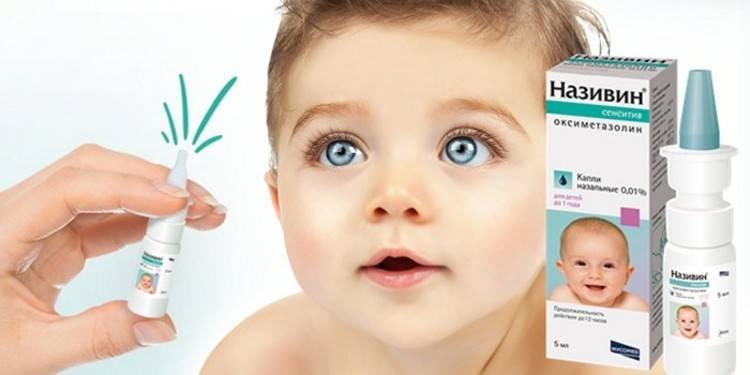
Spray Nazivin Baby
In case of severe swelling of the nasal mucosa, it is worth using vasoconstrictor nasal medications:
- Nazivin Baby;
- Nazol for children;
- Sanorin;
- Otrivin.
Therapy with folk remedies
Many parents prefer traditional methods in the treatment of rhinitis in children. They are safer and more gentle than pharmaceutical products. In addition, addiction does not develop to them; they can be used from birth.
The essence of folk remedies is to use the medicinal properties of plants and products. Non-traditional methods can be combined with drug therapy. This will give a faster and more pronounced effect.
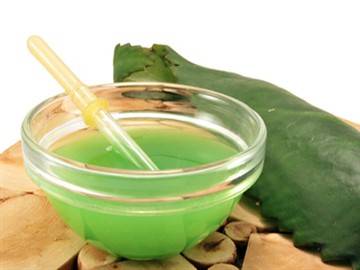
Recipes for effective folk remedies for rhinitis:
- Mix carrot and beet juice and water in equal quantities. Place 1-2 drops into the baby's nose every 2-3 hours. To achieve a more pronounced effect, you can make turundas: moisten cotton-gauze swabs in juice and place in the nostrils for 10-15 minutes;
- Pour a teaspoon of chamomile into a glass of boiling water and leave until the liquid reaches room temperature. Rinse your nose with the resulting product;
- Rinse Kalanchoe leaves thoroughly. Squeeze the juice and dilute it with water in a ratio of 1:10. Place 1-2 drops into each nostril four times a day.
Cautions for Parents
If, nevertheless, parents decide to use the folk remedy discussed in the article for a runny nose in a baby, then they should know that they should not expect a quick relief from snot. Breast milk has preventative qualities, not curative ones.
See also
The best homeopathic remedies for treating runny nose and nasal congestion
Read
When choosing how to treat a baby’s runny nose: whether to drip breast milk into the nose or not, you must act with caution and use saline solution to dilute the milk. In its pure form, when it gets into the sinuses, the product often turns into a cheesy mass, which will be very difficult and problematic to get rid of.
Before deciding to drop milk into the nose, you should consult a pediatrician so as not to harm the child. Most parents are confident that the natural product will not harm the baby, but the use of nasal drops can only worsen the condition.
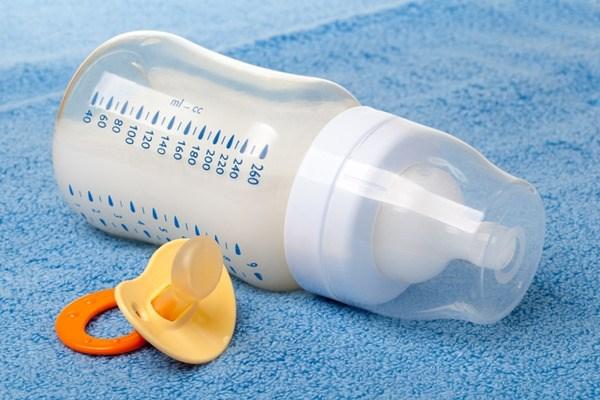
To dispel this myth, it is worth saying that today, to get rid of runny nose in infants, products containing toxins are not used. Most medications for children are created using saline or sea salt as a basis, which help relieve inflammation.
Doctors are extremely negative about the fact that breast milk drips from a runny nose in infants. When eating such a product, the child’s immunity increases and, along with it, the body’s resistance to colds.
It is important not to forget: women are often carriers of pathogens. Once in a child’s body, microbes can cause very serious diseases.
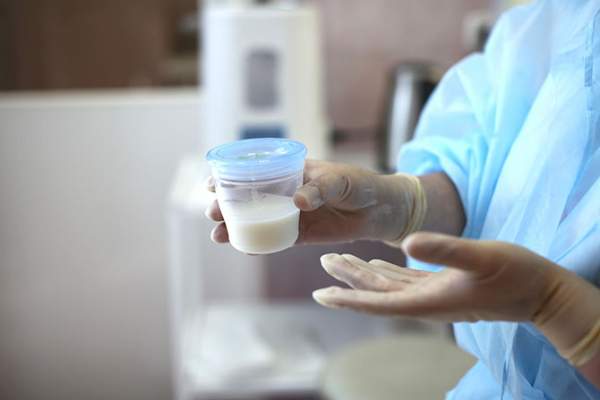
Possible benefits
The only way to use milk for a runny nose rationally and without harming the child is to use it as a mucolytic and moisturizer. In this role, it helps - not as good as products that can be bought at the pharmacy, but good enough for treatment at home. It is necessary to dilute the milk with saline solution in a ratio of one to one and drip it into the baby’s nose twice a day. You need to do it like this:
- Express the milk and dilute it with saline, stirring well.
- Use a pipette to collect a few drops.
- Carefully, holding the baby's head, insert the tip of the pipette into his nose.
- Drop two drops - more will simply not benefit the body.
After the procedure, the pipette must be washed. The consequences will be as follows:
- The mucus will become more liquid, which will facilitate its rapid removal from the body and make it easier for the baby to breathe.
- The dry crusts that occur if the air the baby breathes is too dry and the mucus dries out before it has time to leave the nose will soften.
Some time after the procedure, accumulated mucus should be removed using a rubber bulb
This is easy to do - you need to lubricate the tip of the bulb with Vaseline, release the air from it, insert the tip into the baby’s nose and carefully, smoothly open your hand
The main thing is to do this gently enough so that the sudden pressure drop does not damage the walls of the blood vessels. If after the procedure the child still has softened crusts in his nose, you should use cotton swabs and milk, which helps in this situation. Need to:
Take cotton pads, which are better suited than cotton wool, because they do not fray or fall apart into fibers, and roll them into two thin flagella along the diameter of the baby’s nostrils. Dip them in breast milk diluted with saline and insert them into the nose. Leave for a while so that the dry mucus has time to soften and fall off the mucous membrane.. Carefully turn the flagella a couple of times and carefully pull them out.
The procedure should be carried out when the child is calm and not fidgeting. A good solution would be to involve an assistant who can distract the child from what is happening with his nose.
But a much more effective therapy would be to simply feed the baby milk (it is also effective if the mother also has a runny nose - this, due to the increased amount of antibodies in the blood, will be an excellent help for the baby’s body in the fight against the disease), while simultaneously contacting a pediatrician , who can make a diagnosis and prescribe official treatment that will help with a runny nose.
Types of runny nose and their causes
In total, there are 4 main types of runny nose. He can be:
- Physiological runny nose. Such a runny nose in infants often occurs at 1-3 months and does not require therapy. Its appearance is explained quite simply. During pregnancy, while the baby lived inside the mother, he was constantly in liquid. As a result, the formation of mucous membranes begins only after birth. At the initial stage, the nasal passages are completely dry, only a few weeks after birth the production of mucus begins. Since this mechanism has not yet been established and the passages are quite narrow, the child may experience small amounts of clear liquid discharge. Snot in a one-month-old baby is a natural phenomenon that is not dangerous for the baby and does not cause him any particular inconvenience. After some time, such a runny nose in an infant goes away on its own without treatment, which in such a situation can only cause harm.
- Infectious or viral. The cause of the disease is an infection provoked by either a bacteria or a virus, and snot acts as a protective reaction of the body.
- Allergic. It can be triggered by all sorts of allergens - for example, dust, flowers, household chemicals, animals or foods from the mother's diet, which he gets through her milk during breastfeeding. In this case, watery eyes are added to a runny nose.
- Vasomotor. It is rare in infants. Appears when there are problems with the vessels of the nasal mucosa.
You should also not exclude the possibility of congenital pathologies of the nasal passages and nasopharynx - for example, a deviated nasal septum, complete or partial fusion of the choanae, hemangiomas, polyps and tumors. Such deviations from the norm can cause mucus discharge in a 3-4 month old baby.
In infants, the most common pathology is fusion of the choanae. In this case, the exit to the nasopharynx from the nasal passages is blocked, resulting in a complete or partial cessation of breathing through the nose. It is advisable not to skip or delay a preventive examination by an ENT specialist - usually carried out at 3 and 12 months.
Simple rules for non-drug treatment of a runny nose
Thinning mucus in children can be done naturally. To do this, you need to follow the rules of breastfeeding and additionally let your baby drink more water. Drinking large volumes of liquid will also not hurt the mother herself. So it will reduce the viscosity of breast milk, the composition of which directly affects all substances produced by the child’s body, including nasal mucus.
A positive preventive effect can be achieved by warming the child. Maintaining normal immune system function and preventing hypothermia play an important role in preventing infectious complications. If, however, the baby experiences an increase in cough, an increase in body temperature or shortness of breath, then you should immediately consult a doctor. Antibacterial therapy may be required.
If a severe viral infection is detected, the child will be prescribed treatment aimed at maintaining immunity and symptomatic therapy to relieve manifestations of the disease that worsen the child’s well-being. The symptoms of rhinitis in mild forms of ARVI disappear on their own within one week.
Children 9 months of age and older are allowed to undergo vitamin therapy according to strict indications to strengthen the immune system.
The main symptoms of a runny nose in infants
In infancy, the child is not yet able to breathe through the mouth, and since his nasal passages are quite narrow, the mucous membrane, swelling, makes breathing very difficult. As a result, a simple runny nose in an infant is a very tiresome symptom that causes severe discomfort to the baby. With a clogged nose, the baby becomes capricious, refuses to eat, and sleeps poorly.
Usually a runny nose in a newborn lasts about two weeks. At first, the baby experiences copious mucus secretion, and during a cold or due to hypothermia, it may also be accompanied by a rise in body temperature.
A runny nose is most often accompanied by:
- copious watery discharge from the nose;
- deterioration of general condition against the background of elevated temperature, starting from 37 ° C;
- the appearance of shortness of breath and disruption of normal breathing;
- deviations from the usual rhythm of life, including disturbances in sleep, wakefulness and diet;
- refusal of the breast or bottle and frequent breaks in the sucking process.
In cases where the cause of a runny nose is an allergy, it is characterized not only by watery discharge, but also by attacks of sneezing, redness of the eyes and itching near the nose. Also, when there is a runny nose or congestion in the respiratory tract, an infant unconsciously reaches out with his hands to his nose and rubs it.
Treatment of runny nose for children with the best folk remedies
First of all, it is necessary to understand the reason why a runny nose appears. This is swelling of the nasal mucosa, resulting in more abundant mucus secretion.
Most pharmaceutical drugs do not cure a runny nose, but only help relieve swelling of the nasal mucosa. Many of them are addictive, and therefore you can use them no more than 5-6 times. And if the dose is exceeded, there is a great danger of poisoning. Realizing this, many parents choose traditional methods.
Let's try to describe some of them.
Folk remedies for runny nose for children
- Onion
- Garlic
- Kalanchoe
- Inhalations
- Salt
- Aloe
- carrot juice
- Beet
- Beverages
Onion
- Finely chop and saute in a dry and clean frying pan until the juice appears.
- Then carefully transfer to a clean plate and pour in sunflower oil.
- Let this entire mixture sit for 20-25 hours.
- The solution must be carefully filtered and instilled into the nose, one or two drops at a time. For example, morning and evening.
This method has been used for quite a long time, especially in villages. It gets rid of a runny nose pretty quickly.
For children under one year old, it is best to drip beetroot or carrot juice diluted with water into the nose rather than onion mixture.
Garlic
For older children and not very capricious children, a recipe made from crushed garlic is suitable.
- Crush several cloves of garlic in a garlic press and pour in the squeezed oil along with the juice. It is best to use olive oil, but if you don’t have that, then sunflower oil will do.
- Afterwards, let the mixture sit for about 6-8 hours, and drop 1-2 drops into your nose. It will sting, but if you have a little patience, your runny nose will go away.
Kalanchoe
A very common folk method among city residents. This plant is found in many apartments.
- In the initial stages of a runny nose, wiping the nasal mucosa with fresh juice from a plant leaf helps quite quickly.
- If the runny nose has already begun in full force, then you should drip 5-6 drops of fresh Kalanchoe juice into each nostril. This will greatly improve your overall condition.
Inhalations
You can resort to alkaline inhalation.
- To do this, you need to boil a kettle and dilute 3-4 tablespoons of baking soda in water.
- Cover it all with a towel and let the child breathe in the steam.
You need to carefully monitor the temperature of the steam so as not to burn the mucous membrane!
Before treating a child, the site must be carefully prepared. During the entire period of inhalation, it is necessary to hold the baby in your arms, controlling his hands so that he does not pull the hot water onto himself!
Fir or eucalyptus oils are also good for relieving swelling of the nasal mucosa. At home, you can add 2-3 drops of this oil to a pan of boiling water, cover with a towel and let the child breathe.
Salt
Another old and effective method.
- In 100 ml of hot boiled water you need to dilute half a teaspoon of table salt.
- Moisten a swab in the resulting solution and wipe the child’s mucous membrane with it. Salt relieves swelling.
Aloe
A very effective way.
- Wash aloe leaves thoroughly in hot boiled water.
- Squeeze the juice out of them and dilute it with boiled water, in a ratio of one to ten.
- Apply 3-4 drops to your nose 5-6 times a day.
carrot juice
This recipe can be classified as a more complex, but very effective method.
- To prepare it, you will need a tablespoon of freshly squeezed carrot juice, one tablespoon of olive oil (you can use sunflower oil), which should first be boiled in a water bath, and three drops of garlic juice.
- All this must be mixed and dripped 2-3 drops into each nostril 3-4 times a day.
The peculiarity of this recipe is that it needs to be prepared every day, because although it has a very powerful healing effect, it spoils very quickly.
Beet
For very young children, nasal swabs soaked in fresh, just squeezed beet juice, which need to be placed in each nostril for 5-10 minutes 3-4 times a day, are very helpful for a runny nose.
Treatment should be carried out strictly under the supervision of parents. Do not put tampons deep, leave most of them out!
Traditional drinks and decoctions for a runny nose
There are also folk remedies for the common cold that are taken orally.
- An old folk recipe is very suitable for children, for the preparation of which you need to mix Kalanchoe juice and honey in equal proportions, and drink the mixture with an infusion of lemon balm or St. John's wort.
- The following recipe works well: grate the onion into a paste and mix it in equal parts with honey. Give the child one teaspoon of the mixture 3-4 times a day 30 minutes before meals.
How to cure a runny nose
Is it possible to give manta to a child with a runny nose or cold?
To treat a runny nose, it is recommended to use the methods proposed by traditional medicine: drip vasoconstrictor or antiallergic drops into the nose, use antiviral and antipyretic drugs, rinse the child’s nose, etc.
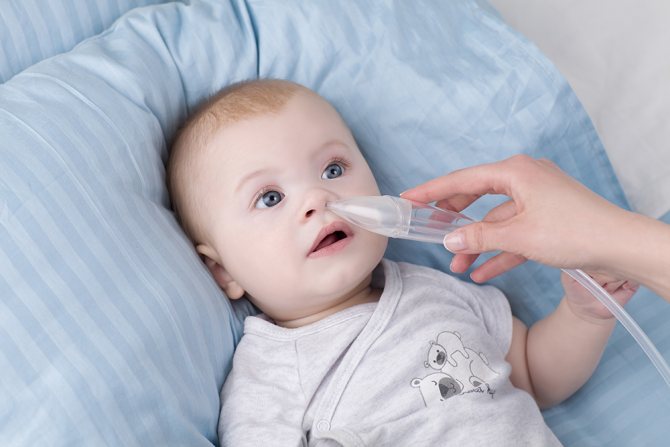
Treatment for rhinitis should be prescribed by a pediatrician
Despite the fact that rhinitis is not considered a serious disease, you should consult your pediatrician for treatment. The doctor knows best how many drops to put into the nose and how many tablets to use in a particular case.
The most popular cold remedies for newborns
There are many medications in pharmacies intended for children under 1 year of age that help get rid of nasal congestion. However, not every drop can give a positive result.
In addition, each of them has its own characteristics and purpose, which must be taken into account when choosing drops for the common cold for infants. In order not to harm the newborn, you can independently use nasal drops for infants with salt even before the doctor arrives. The most famous in this group are:
Salt drops
- Drops "Aqua Maris"
The drops contain sea water and natural trace elements (calcium, magnesium and sodium). The drug is effective in the following cases:
- Severe rhinitis or its chronic manifestation;
- Allergic reaction;
- As a prophylaxis during seasonal exacerbation of colds;
- Carrying out hygiene procedures, washing the newborn’s nose.
Forms of release of "Aqua Maris": spray or nasal drops.
The spray is available in small bottles (50 ml each) with a special nozzle intended for a newborn.
The drops are sold in small 10 ml bottles along with a pipette. You can use the product 2-3 times a day, two drops in each nose.
Read more about these drops in the article: Aquamaris for newborns>>>
- Drops "Aqualor Baby"
The drops also contain sea water. The drug is unique in that the components it contains are of natural origin - nasal drops for newborns do not contain preservatives. The drug "Aqualor Baby" is intended to cleanse the nasal cavity, facilitate breathing, reduce inflammation and increase immunity.
Drops are used for:
- Carrying out daily hygiene procedures;
- Preparing the newborn’s nose for subsequent manipulations with medications;
- Treatment and prevention of viral and colds.
Release form: spray and nasal drops.
The spray is sold in pharmacies in the form of a compact can with a convenient nozzle and a safety lock that will not allow you to hurt your baby. It is used in the same way as regular drops - inject the drug, slightly tilting the baby's head to one side, and then, using an aspirator, remove all the “poop” from the nose.
Drops are available in small bottles of 15 ml. It is recommended to instill 2-3 times a day, depending on the severity of rhinitis.
- Drops "Salin"
The basis of the drug is a saline solution, the concentration of which corresponds to the composition of the physiological fluid in the nose. Therefore, Salin dilutes the accumulated mucus and softens the crusts. Additional components have an anti-edematous and antiseptic effect.
- Drops "Otrivin Baby"
Contains sea salt and excipients. Effectively cleanses the newborn's nose, facilitates breathing, and increases local immunity.
The most famous vasoconstrictor drops for infants include:
Vasoconstrictor drops
- Drops "Nazol Baby"
Drops can be used as a prophylactic agent. The drug reduces swelling of the mucous membrane and makes breathing easier for the newborn.
Is used for:
- Daily hygiene procedures;
- Prevention and treatment of colds;
- Reducing allergic reactions;
- Facilitate the newborn's breathing before feeding and during sleep.
Attention! Nazol Baby drops cannot be taken because “they helped the neighbor’s boy” - the drug has a number of contraindications that you need to become familiar with
- Nazivin
- Vibrocil.
All of them can be used for children from birth to treat colds, ARVI, flu, and allergic rhinitis. Apply drops up to 4 times a day for no more than 3 days. The drugs have contraindications.
Homeopathic drops
For example, Euphorbium Compositum is used for treatment and prevention in children of all ages, including newborns. The drug improves immunity and has an anti-inflammatory effect.
Antiallergic, antibacterial drops for children under 1 year of age are used in extreme cases and only as directed and under the supervision of a specialist.
Basic approaches to treatment
The natural desire of any mother, as soon as the baby’s snot starts flowing, is to help him get rid of it. However, the treatment of a runny nose directly depends on the exact reasons that led to its appearance. Before you try to cure a child with various methods, you need to understand why the baby has snot, and for this you need to have him examined by a pediatrician. The doctor, having seen the nasal discharge and assessed the patient’s condition, will be able to make a diagnosis and prescribe appropriate treatment.
In case of ARVI
In the first six months, breastfed children rarely experience ARVI. This is due to the fact that mother’s milk contains a large amount of immunoglobulins that protect the child’s body from infections of a viral and bacterial nature. In infancy, experts recommend using a minimum number of medications so as not to provoke a possible allergic reaction.
In case of ARVI, parents should resort to the following measures:
- Clean your nose with saline solutions. To do this, you can buy regular saline solution at the pharmacy or make a special solution for instillation into the nose at home. Boiled water in its pure form is not suitable for these purposes, as it will irritate the nasal mucosa. Examples of pharmaceutical antiseptics are Furacilin and Miramistin.
- Use antiviral nasal drops. They are based on interferon. They help strengthen local immunity and prevent the virus from spreading.
- Use local immunomodulators. The most commonly prescribed nasal drops are Derinat. However, many pediatricians are of the opinion that it is not worth treating ARVI in infants with immunomodulators, since their immunity is in the process of formation and their use can negatively affect their health.
For a runny nose with ARVI, Derinat nasal drops are successfully used
- Treat with homeopathic drops. Their use is quite common in the treatment of snot in infants. With rare exceptions, they do not cause an allergic reaction. In the first year of life, homeopathic drops “Euphorbium Compositum” are usually prescribed.
For complications of a bacterial nature
Complications of a bacterial nature include diseases such as otitis media, sinusitis, adenoiditis, and conjunctivitis. Typically, in such situations, antibacterial therapy is required, which consists of using:
- Local antibiotics. They are usually included in nasal drops. The use of local antibiotics is contraindicated for children under 2-3 years of age. However, in severe cases of otitis or sinusitis, the pediatrician may prescribe them with a lower dosage.
- Systemic antibiotics. Their use is justified in case of prolonged purulent runny nose, which signals the presence of sinusitis in the baby. Also, penicillin antibiotics are highly effective against streptococcal and staphylococcal infections. Unfortunately, penicillin can often cause allergies in infants, and then the doctor prescribes an antibiotic from a different group.
- Vasoconstrictor drops. They are used as an anesthetic for otitis media, as such drops quickly relieve swelling and reduce pain in the ear. In addition to otitis media, they can be prescribed in case of prolonged difficulty breathing through the nose. Lack of oxygen due to impaired breathing can negatively affect the overall development of the body's nervous system. For newborns, drops with a mild effect, for example, Otrivin, are more suitable. “Vibrocil” or “Nasivin” is used after 1 year (we recommend reading: can “Vibrocil” be given to an infant?).
- Antiseptic drops. “Protargol” is the most popular among mothers of infants. This silver solution is widely used among ENT specialists. It is important to follow the dosage when using it, since an overdose causes severe drying, tightening of the mucous membrane and accumulation of silver in the body.
During allergies
For the treatment of allergic rhinitis, antihistamines, vasoconstrictor drops, or hormonal medications can be prescribed if the baby has long-term nasal congestion. However, it usually goes away if all possible allergens are eliminated. To do this you need:
How to treat a runny nose in newborns?
As a mother who loves her child, this question certainly worries you very much. You must begin your path to combating a runny nose by clearing mucus from the newborn’s nasal passages. To do this, depending on the size of the child's nose, you can use cotton wool. For information on how to use them correctly, read the article on how to properly clean a newborn’s nose>>>
An excellent alternative to such nasal cleansing is the use of a sterile sea salt solution and an aspirator. Nowadays there is a wide range of these products for children, and besides, they are easy to use. You just need to drop or inject this solution into your newborn baby’s nose, and then remove the nozzles with an aspirator. Read about how to choose and use a newborn aspirator>>>
At the same time, do not worry that the baby’s discharge will get into your mouth; this is absolutely impossible, thanks to the design of the aspirator. But the effectiveness of such a procedure for a child is very high. Sea water very gently thins the mucus and allows it to be better separated from the newborn’s nose.
Important! Keep in mind that you should never rinse the spout or inject liquid under strong pressure. Remember, your task is to do your best to alleviate the condition of your newborn baby and prevent the mucus from thickening or, even worse, drying out.
For a baby who breathes only through his nose for at least one year, this is very dangerous.
Remember, your task is to alleviate the condition of your newborn baby with all your might and not to allow the mucus to thicken or, even worse, dry out. For a baby who breathes only through his nose for at least one year, this is very dangerous.
It is necessary to prevent not only the child’s mucous membrane from drying out, but also the room. Get a humidifier; if this is not possible, then hang out wet laundry or place a bowl of water in the newborn’s room. Similar article: temperature in the room for a newborn>>>
Surely you have already heard that when you have a runny nose, you need to instill breast milk into your baby’s nasal passages? Opinions about this method of treatment are conflicting.
- Some consider this option as an ineffective and even dangerous relic of the past. After all, milk is, first and foremost, food, and if you start putting it in your nose, you will thereby create a favorable environment for the proliferation of harmful microorganisms;
- Other mothers, on the contrary, use it. Milk contains many protective factors that can prevent disease.
What to choose - decide for yourself.
Is it possible to treat a baby's runny nose with breast milk?
Breast milk from a running nose is recommended by grandmothers. This is how children of past generations were treated. Women believe that breast milk has healing effects and can even treat dangerous diseases.
Natural baby food actually contains a lot of useful substances. However, modern pediatricians advise not to put it in the baby's nose or eyes. Doctors consider this treatment method useless and even dangerous.
How did the recommendation to be treated with breast milk come about?
Dripping breast milk into the nose is usually recommended for women of past generations. For many decades, this method has successfully helped children suffering from colds and rhinitis. Natural baby food contains immunoglobulins. They stimulate the child’s immunity and increase the body’s resistance.
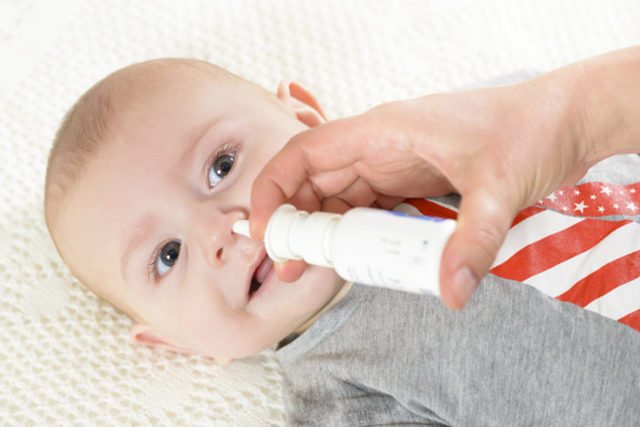
Treatment for breast milk rhinitis is believed to be:
- increases local immunity;
- moisturizes the mucous membrane in the nasal passages;
- softens crusts;
- destroys infectious agents, viruses and bacteria.
Like most modern pediatricians, Dr. Komarovsky does not recommend putting breast milk into the nose.
This treatment was used because medicine was undeveloped. Mothers do not have access to effective medicines and are sometimes forced to rely on folk remedies.
With the development of medicine, alternative methods of treatment have faded into the background. They are still recommended by grandmothers, especially for young children. However, such methods are not recognized by traditional medicine. Breast milk that drips into your eyes and nose is pointless. If you have complaints, it is better to contact your pediatrician and get an individual treatment plan with safe medications.

Should I put it in my eyes or nose?
Grandmothers recommend that new mothers stop breast milk every time they breastfeed if their nose starts to hurt. The more often the procedure is performed, the faster the child recovers. This is not entirely true. Modern pediatricians, eye and ear, nose and throat specialists tell why conjunctivitis and rhinitis in a newborn cannot be cured with breast milk.
- Breast milk is a nutritious liquid containing various beneficial components. It is considered an ideal food for a child and helps build a strong immune system because it contains antibodies. However, human milk is not capable of destroying bacteria and viruses. It works inside the body and does not have a local antiseptic effect. Pouring breast milk into a baby's nose is simply pointless.
- The nasal mucosa self-cleanses due to the ciliary epithelium and secretory activity. The resulting mucus washes away harmful microorganisms and protects the internal cavity of the nose. When you put milk in a baby's nose, the eyelashes stick together. You will no longer be able to remove mucus and clear your nasal cavity. This can lead to complications. Therefore, the use of this type of treatment is dangerous.
- Sugar is found in breast milk. They create a breeding ground for bacteria. If you do this procedure regularly, you will get an infection in your nose. For the same reason, milk should not be buried in the eyes of a newborn. Unconventional treatment methods will lead to dangerous bacterial diseases.
Breast milk for a runny nose in infants: is it possible to drip into a child’s nose?
A runny nose is a symptom that occurs in many diseases. Most adults do not take this seriously, and heavy discharge is uncomfortable for them only in the first days. How difficult it is for small children and infants. Discharge quickly blocks the narrow nasal passages, which leads to rapid swelling of the mucous membrane. Children can hardly breathe through their mouth, which leads to anxiety and sleep disturbances.
A baby's runny nose is much more problematic than an adult's runny nose.
Nasal correction interferes with the baby's normal breathing, bottle feeding, and breastfeeding. They refuse food and lose weight. The disease drags on because the body does not receive enough nutrients and immunity decreases. When the infection spreads, pharyngitis is added to the runny nose, complications such as bronchitis, otitis and sinusitis may occur.
Grandmothers suggest sprinkling breast milk on the baby's nose. These tips are passed down from generation to generation because for many centuries people have been treated using traditional medicine.
Elders in the family believe that breast milk with runny nose can actually help fight the disease. We should use it regularly on our nose, and very soon the broken farmer will retire.
This is true?
Breast milk has a runny nose
Breast milk for a runny nose: pros and cons
The older generation and traditional healers explain the positive effect of breast milk on a runny nose by the fact that it contains maternal antibodies, which help the child’s body resist viruses and bacteria. In fact, a large amount of immunoglobulins in milk contributes to the formation of immunity in a child, but only if the newborn eats them.
Coated milk from a runny nose can only worsen the child's condition
Rising to the mucous outflow, milk antibodies do not protect the body from infection, since they work only in blood plasma.
Breast milk for a runny nose can 'help' in cases where the illness would go away without treatment. It softens the dried crust, but there are many other effective ways to do this.
Grandmother's advice to drip breast milk into your nose while your nose is running can be called harmful.
Harm from using breast milk for a runny nose
By extracting breast milk for bacterial rhinitis, the mother herself, unwillingly, helps transmit the infection to the sinuses and throat.
This is associated with serious complications: otitis media, pharyngitis, sinusitis, which develop within several hours and require hospitalization. So it is harmful to breast milk when it drips into the baby's nose.
Treatment must be approved by a doctor and specific medications must be used that are safe for children.
How to help a baby with a runny nose?
For the depriver Leakage of fluid, constant sneezing, irritation of the skin under the nose, restlessness, refusal to eat, lethargy, fever should be vigilant and forceful. The child’s illness is always more severe, up to one year. The child cannot blow his nose, and parents cannot always blow his nose effectively.
The nasal passages and nasal cavity in infants are small, slimy, sensitive, vulnerable and swell quickly. The swelling is especially pronounced on the first and second days. This is the most turbulent time for the baby and his parents, who have difficulty feeding milk, distracting and calming the baby. Swelling drops gradually appear, the discharge thickens and crusts form.
INTERNATIONAL: How to properly clean a newborn baby's nose?
Humidifying the baby's room
Pay attention to the indoor climate, ventilate more often, and humidify the air in winter
It is important to pay special attention to the microclimate in the house during the baby’s illness. Dry air in the heat and during the heating season dries out the mucus in the nose. The resulting crusts are difficult to remove without causing pain to the child.
The resulting crusts are difficult to remove without causing pain to the child.
Dry air in the heat and during the heating season dries out the mucus in the nose. The resulting crusts are difficult to remove without causing pain to the child.
In addition, the mucus itself contains many substances that can act against a runny nose. For their effectiveness, the viscosity of the mucus must be optimal.
Moisturize the mucous membranes:
- regular wet cleaning;
- drinking regimen (frequent application to the chest, water from a spoonful of bottles);
- walks in good weather (without fever);
- buried in a salt outflow;
- inhalation with alkaline mineral water or salt solution using a nebulizer for nursing infants.
Composition of breast milk
Breast milk supplies the baby with a huge amount of substances that are vital for normal development. It also contains minerals, organic acids, many vitamins, proteins, proteins responsible for the normal growth of bones and muscle tissue.
There is lactose, it is the main source of carbohydrates, fatty acids, vitamins, microelements, macroelements that contribute to the normal development of skeletal bones. Milk also contains antibodies; they prevent the passage of germs and viruses that lead to nasal congestion and sore throat.
We recommend reading: A baby has constipation while breastfeeding: what to do, reasons
Mother's milk is superior in its benefits to ordinary cow's milk and infant formula.
